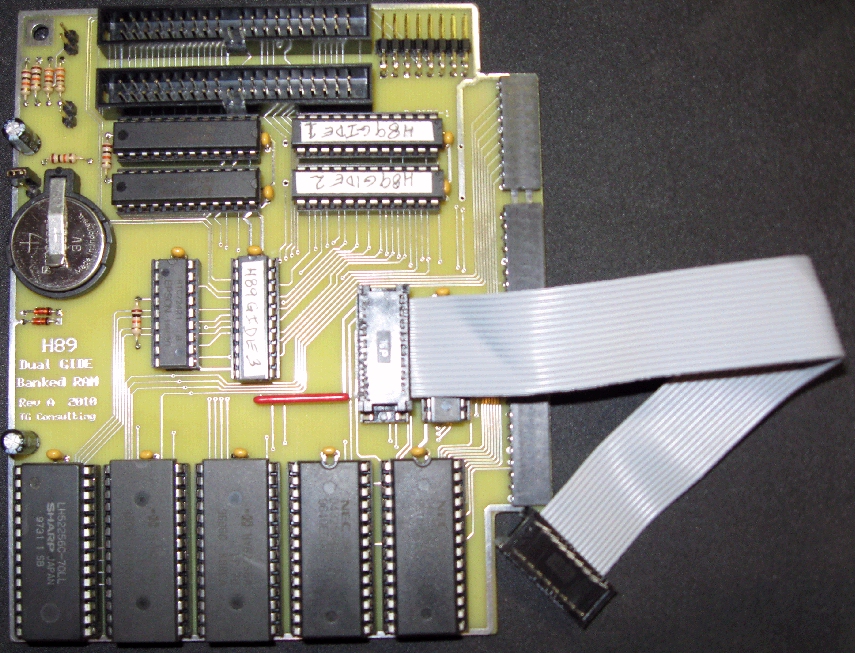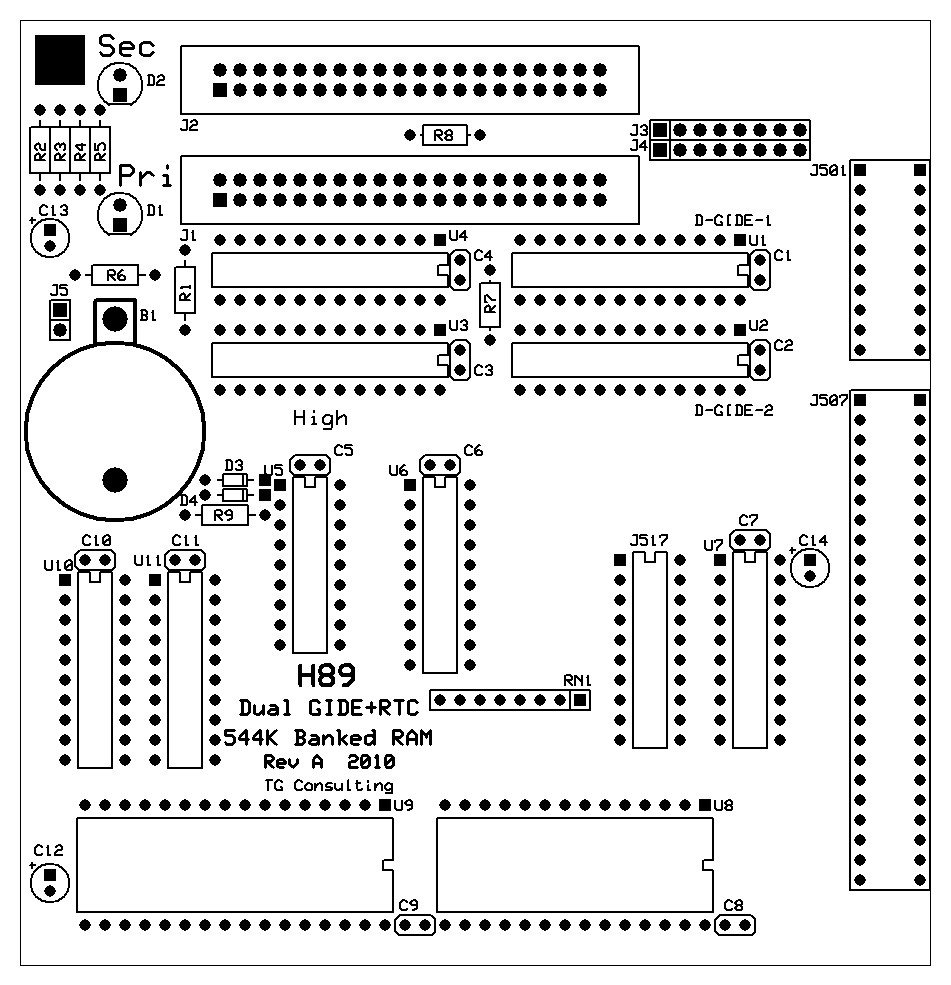
Heath H89 Dual GIDE
The Heath H89 Dual GIDE is now available in kit form. The basic kit consists of the following:
- Printed Circuit Board. The PCB mounts in a left side expansion slot (the memory side) and connects to the mainboard via a ribbon cable to the mainboard backplane to pick up several Z80 signals.
- Boot EPROM. The Boot EPROM works in conjunction with the Heath MTR90 EPROM so the machine can boot from any one of the four IDE drives, along with the original H17, H37, H47 and H/Z67 boot properties.
- All PCB components and connectors are supplied.
- CP/M software (NO HDOS!) is supplied on a boot-capable Compact Flash module. You may purchase a CF-IDE adapter at an additional cost (more info below). The adapter comes with a very short data cable that will connect to the D-GIDE. A full length IDE data cable is NOT included.
Note that installation REQUIRES soldering to the back side of the main CPU PCB. If you are not comfortable doing that, you can make arrangements to have it done for you at a slight additional charge.
Optional Components
The D-GIDE PCB contains provisions for two options: Real Time Clock and 544K Static RAM.
RTC
The Real Time Clock (RTC) is based on the Epson 72421 RTC. It has battery backup for periods of power down. The EPROM displays the time (HH:MM) on the command line. A CP/M utility for displaying/setting the clock is supplied.
544KB RAM
The H89's dynamic RAM is completely replaced by the static RAM on the D-GIDE. A ribbon cable connects the D-GIDE to the mainboard at U517 - the Memory Map Decoder - to provide the required signals to generate the necessary mapping. The PROM at U517 is no longer used. All 4116 dynamic RAM is removed from the mainboard, along with a few other support chips. The H89's heat generation and power consumption is greatly reduced by this change.
RAM Banking is also supported, with sixteen banks of 32K swappable, and a single 32K bank that is always in context. One bank is used for the TPA, a second bank contains portions of the operating system, and two banks are dedicated to the user; the remaining 12 banks are used to form a 384K RamDisk.
Additional memory is not the only advantage with the RAM replacement. You'll also be able to run a faster system clock - 6MHz has been tested; faster speeds may be possible. Replacing the (in some cases) 450nSec dynamic RAM with 70nSec Static RAM allows a much faster system clock. Most I/O will be unaffected; H17 I/O requires that the speed be dropped to 2MHz - this is handled via the driver software.
The PCB
This is a fully populated, late-model prototype board. The final production board will have a single 32K RAM and a single 512K RAM instead of five 32K RAMs. The ribbon cable shown is 16-pin rather than the 20-pin cable that is required to connect to U517.

The final revision PCB is now on-hand. The mechanical drawing looks like this:

A Compact Flash to IDE adapter is required to get the software from the CF module to your IDE device, be it a hard drive, another CF adapter module, or an SD-IDE module that are becoming popular. If you already have the CF-IDE adapter, you're good to go. If you don't have one, you can purchase it here or elsewhere, but you MUST have one.
The Software
Software consists of the EPROM, the Operating System, and the Utilities. All software is delivered on a single Compact Flash module; floppy disk options are far too numerous to support and the capacity is far too low. The Compact Flash includes over 16MB of data files, utilities, languages, compilers, disassemblers, etc.
As mentioned earlier, the EPROM replaces the H89's system EPROM at U518. It provides boot capability to both Master IDE drives, as well as the original Heath H17, H37 and H47 drives.
The Operating System (CP/M ONLY!) is a fully configured Z-System with ZCPR3 and ZSDOS, and a highly customized BIOS that takes advantage of the banked RAM, RTC, and IDE interface. The IDE drives are partitioned into ten, 8MB partitions, any four of which are on-line at any given time. Off-line partitions can be activated with a simple command line. Multiple drives are also possible, with four, 8MB partitions each. With some portion of the BIOS in Banked RAM, it is possible to have as many as 12 drives on-line at one time.
The 384K RamDisk is just large enough to hold most of your favorite utilities. Copy them to the A16: User Area and they will be copied to the RamDisk at Cold Boot. This is far faster than even an IDE drive.
Costs
Cost for the full kit has been pegged at $100, shipped. This includes all software on a CF module, plus a CF-IDE adapter to read and boot the CF module.